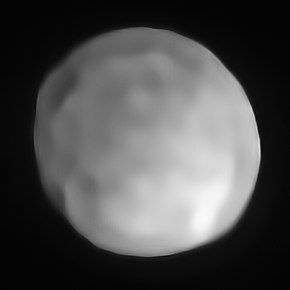
Back 10 Hugiëia Afrikaans (10) Hygiea ALS 10 هيجيا Arabic 10 هيجيا (كويكب) ARZ 10 Hygiea AST (10) Гігея Byelorussian 10 Хигия Bulgarian (10) Hygiea Breton (10) Higiea Catalan (10) Гигея CE
 VLT-SPHERE image of Hygiea | |
| Discovery[1] | |
|---|---|
| Discovered by | A. de Gasparis |
| Discovery site | Astronomical Observatory of Capodimonte |
| Discovery date | 12 April 1849 |
| Designations | |
| (10) Hygiea | |
| Pronunciation | /haɪˈdʒiːə/[2] |
Named after | Hygieia[3] |
| A900 GA | |
| Main belt (Hygiea family) | |
| Adjectives | Hygiean /haɪˈdʒiːən/[4] |
| Symbol | |
| Orbital characteristics[1] | |
| Epoch 27 April 2019 (JD 2458600.5) | |
| Uncertainty parameter 0 | |
| Observation arc | 170.23 yr (62,175 days) |
| Aphelion | 3.4948 AU |
| Perihelion | 2.7882 AU |
| 3.1415 AU | |
| Eccentricity | 0.1125 |
| 5.57 yr (2033.8 days) | |
Average orbital speed | 16.76 km/s |
| 152.18° | |
| Inclination | 3.8316° |
| 283.20° | |
| 312.32° | |
| Proper orbital elements[5] | |
Proper semi-major axis | 3.14178 AU |
Proper eccentricity | 0.1356 |
Proper inclination | 5.1039° |
Proper mean motion | 64.6218 deg / yr |
Proper orbital period | 5.57088 yr (2034.762 d) |
Precession of perihelion | 128.544 arcsec / yr |
Precession of the ascending node | −96.9024 arcsec / yr |
| Physical characteristics | |
| Dimensions | 450 km × 430 km × 424 km ± 10 km × 10 km × 20 km |
| 433±8 km[6] 434±14 km[7] | |
| Flattening | 0.06[a] |
| Mass | (8.74±0.69)×1019 kg[6] (8.32±0.80)×1019 kg (representative)[8] |
Mean density | 2.06±0.20 g/cm3[6] 1.94±0.19 g/cm3[8] |
| 13.82559±0.00005 h[7] | |
| 0.063[6] 0.0717±0.002[1] | |
| Temperature | ≈164 K max: 247 K (−26°C)[9] |
| C-type[1] | |
| 9.0[10] to 11.97 | |
| 5.64[1] | |
| 0.321″ to 0.133″ | |
10 Hygiea is a major asteroid located in the main asteroid belt. With a mean diameter of between 425 and 440 km and a mass estimated to be 3% of the total mass of the belt,[11] it is the fourth-largest asteroid in the Solar System by both volume and mass, and is the largest of the C-type asteroids (dark asteroids with a carbonaceous surface) in classifications that use G type for 1 Ceres. It is very close to spherical, apparently because it had re-accreted after the disruptive impact that produced the large Hygiean family of asteroids.
- ^ a b c d e Cite error: The named reference
jpldatawas invoked but never defined (see the help page). - ^ "Hygeia". Oxford English Dictionary (Online ed.). Oxford University Press. (Subscription or participating institution membership required.)
- ^ Cite error: The named reference
springerwas invoked but never defined (see the help page). - ^ "hygeian". Oxford English Dictionary (Online ed.). Oxford University Press. (Subscription or participating institution membership required.)
- ^ Cite error: The named reference
Hygiea-POEwas invoked but never defined (see the help page). - ^ a b c d e P. Vernazza et al. (2021) VLT/SPHERE imaging survey of the largest main-belt asteroids: Final results and synthesis. Astronomy & Astrophysics 54, A56
- ^ a b Cite error: The named reference
Vernazza2019was invoked but never defined (see the help page). - ^ a b Cite error: The named reference
Vernazza2019bwas invoked but never defined (see the help page). - ^ Cite error: The named reference
Lim2005was invoked but never defined (see the help page). - ^ Cite error: The named reference
AstDys-Hygieawas invoked but never defined (see the help page). - ^ "Mass of 10 Hygiea" 0.445 / "Mass of Mbelt" Archived 2008-10-31 at the Wayback Machine 15 = 0.0296
Cite error: There are <ref group=lower-alpha> tags or {{efn}} templates on this page, but the references will not show without a {{reflist|group=lower-alpha}} template or {{notelist}} template (see the help page).